Effect of Deep Learning Approach on Career Self-Efficacy: Using Off-Campus Internships of Hospitality College Students as an Example
Abstract
:1. Introduction
2. Conceptual Framework and Hypothesis Development
2.1. Relationship between Deep Learning Approach and Self-Regulated Learning
2.2. Relationship between Self-Regulated Learning and Career Self-Efficacy
2.3. Relationship between Deep Learning Approach and Career Self-Efficacy
2.4. Mediating Effect of Self-Regulated Learning
2.5. Moderating Effect of Cognitive Engagement
3. Methodology
3.1. Research Framework
3.2. Pilot Test
3.3. Sample Frame and Data Collection
3.4. Construct Measurement
3.5. Analytic Approach
4. Results
4.1. Demographic Statistics
4.2. CFA
4.3. Path Analysis
5. Discussion
5.1. Theoretical Implications
5.2. Managerial Implications
5.3. Research Limitations and Future Studies
6. Conclusions
Author Contributions
Funding
Institutional Review Board Statement
Informed Consent Statement
Data Availability Statement
Conflicts of Interest
References
- Horng, J.-S.; Lee, M.-H. Tourism and hospitality higher education in Taiwan: Past, present, and future. J. Teach. Travel Tour. 2006, 5, 167–196. [Google Scholar] [CrossRef]
- Lugosi, P.; Jameson, S. Challenges in hospitality management education: Perspectives from the United Kingdom. J. Hosp. Tour. Manag. 2017, 31, 163–172. [Google Scholar] [CrossRef]
- Stierand, M.; Zizka, L. Reflecting on hospitality management education through a practice lens. Qual. Assur. Educ. 2015, 23, 353–363. [Google Scholar] [CrossRef]
- Whitelaw, P.A.; Wrathall, J. Developing practice oriented undergraduate courses in a quality framework: A case study: Bachelor of event management. Qual. Assur. Educ. 2015, 23, 395–409. [Google Scholar] [CrossRef]
- Marton, F.; Säljö, R. On qualitative differences in learning: I—Outcome and process. Br. J. Educ. Psychol. 1976, 46, 4–11. [Google Scholar] [CrossRef]
- LeCun, Y.; Bengio, Y.; Hinton, G. Deep learning. Nature 2015, 521, 436–444. [Google Scholar] [CrossRef]
- Sultan, H.H.; Salem, N.M.; Al-Atabany, W. Multi-classification of brain tumor images using deep neural network. IEEE Access 2019, 7, 69215–69225. [Google Scholar] [CrossRef]
- Zhou, B.L.; Lapedriza, A.; Khosla, A.; Oliva, A.; Torralba, A. Places: A 10 Million Image Database for Scene Recognition. IEEE Trans. Pattern Anal. Mach. Intell. 2018, 40, 1452–1464. [Google Scholar] [CrossRef] [Green Version]
- Shi, D.; Irwin, D.; Du, P. Languaging dynamics in interactive lecturing: Exploring an embodied approach to deep learning in L2 higher education contexts. Classr. Discourse, 2022; in press. [Google Scholar] [CrossRef]
- Offir, B.; Lev, Y.; Bezalel, R. Surface and deep learning processes in distance education: Synchronous versus asynchronous systems. Comput. Educ. 2008, 51, 1172–1183. [Google Scholar] [CrossRef]
- Aguiar-Castillo, L.; Clavijo-Rodriguez, A.; Hernández-López, L.; De Saa-Pérez, P.; Pérez-Jiménez, R. Gamification and deep learning approaches in higher education. J. Hosp. Leis. Sport Tour. Educ. 2021, 29, 100290. [Google Scholar] [CrossRef]
- Golightly, A.; Raath, S. Problem-based learning to foster deep learning in preservice geography teacher education. J. Geogr. 2015, 114, 58–68. [Google Scholar] [CrossRef]
- Hall, M.; Ramsay, A.; Raven, J. Changing the learning environment to promote deep learning approaches in first-year accounting students. Account. Educ. 2004, 13, 489–505. [Google Scholar] [CrossRef] [Green Version]
- Biggs, J.B. Student Approaches to Learning and Studying. Research Monograph; Australian Council for Educational Research: Hawthorn, Australia, 1987. [Google Scholar]
- Heikkilä, A.; Lonka, K. Studying in higher education: Students’ approaches to learning, self-regulation, and cognitive strategies. Stud. High. Educ. 2006, 31, 99–117. [Google Scholar] [CrossRef]
- Bandura, A. Self-efficacy: Toward a unifying theory of behavioral change. Psychol. Rev. 1977, 84, 191. [Google Scholar] [CrossRef]
- Zimmerman, B.J. Attaining self-regulation: A social cognitive perspective. In Handbook of Self-Regulation; Elsevier: Amsterdam, The Netherlands, 2000; pp. 13–39. [Google Scholar]
- Yan, Z. Self-assessment in the process of self-regulated learning and its relationship with academic achievement. Assess. Eval. High. Educ. 2020, 45, 224–238. [Google Scholar] [CrossRef]
- DiBenedetto, M.K.; Bembenutty, H. Within the pipeline: Self-regulated learning, self-efficacy, and socialization among college students in science courses. Learn. Individ. Differ. 2013, 23, 218–224. [Google Scholar] [CrossRef]
- Greene, J.A.; Azevedo, R. A macro-level analysis of SRL processes and their relations to the acquisition of a sophisticated mental model of a complex system. Contemp. Educ. Psychol. 2009, 34, 18–29. [Google Scholar] [CrossRef]
- Perkins, D. The many faces of constructivism. Educ. Leadersh. 1999, 57, 6–11. [Google Scholar]
- Wang, S.-L.; Wu, P.-Y. The role of feedback and self-efficacy on web-based learning: The social cognitive perspective. Comput. Educ. 2008, 51, 1589–1598. [Google Scholar] [CrossRef]
- Betz, N.E.; Hackett, G. The relationship of career-related self-efficacy expectations to perceived career options in college women and men. J. Couns. Psychol. 1981, 28, 399. [Google Scholar] [CrossRef]
- Lent, R.W.; Hackett, G. Career self-efficacy: Empirical status and future directions. J. Vocat. Behav. 1987, 30, 347–382. [Google Scholar] [CrossRef]
- Chen, M.-L. Influence of grade level on perceptual learning style preferences and language learning strategies of Taiwanese English as a foreign language learners. Learn. Individ. Differ. 2009, 19, 304–308. [Google Scholar] [CrossRef]
- Fuchs, L.S.; Fuchs, D.; Prentice, K.; Burch, M.; Hamlett, C.L.; Owen, R.; Schroeter, K. Enhancing third-grade student’mathematical problem solving with self-regulated learning strategies. J. Educ. Psychol. 2003, 95, 306. [Google Scholar] [CrossRef]
- Guterman, O.; Neuman, A. Not all paths lead to success: Learning strategies and achievement among undergraduate students. J. Furth. High. Educ. 2021, 46, 115–127. [Google Scholar] [CrossRef]
- Kadioglu-Akbulut, C.; Uzuntiryaki-Kondakci, E. Implementation of self-regulatory instruction to promote students’ achievement and learning strategies in the high school chemistry classroom. Chem. Educ. Res. Pract. 2021, 22, 12–29. [Google Scholar] [CrossRef]
- Rosário, P.; Núñez, J.C.; Valle, A.; González-Pienda, J.; Lourenço, A. Grade level, study time, and grade retention and their effects on motivation, self-regulated learning strategies, and mathematics achievement: A structural equation model. Eur. J. Psychol. Educ. 2013, 28, 1311–1331. [Google Scholar] [CrossRef]
- Panadero, E.; Alonso Tapia, J. How do students self-regulate?: Review of Zimmerman” s cyclical model of self-regulated learning. An. De Psicol. 2014, 30, 450–462. [Google Scholar]
- Khiat, H. Using automated time management enablers to improve self-regulated learning. Act. Learn. High. Educ. 2019, 23, 3–15. [Google Scholar] [CrossRef]
- Broekkamp, H.; Van Hout-Wolters, B.H. Students’ adaptation of study strategies when preparing for classroom tests. Educ. Psychol. Rev. 2007, 19, 401–428. [Google Scholar] [CrossRef]
- Panadero, E.; Fraile, J.; Fernández Ruiz, J.; Castilla-Estévez, D.; Ruiz, M.A. Spanish university assessment practices: Examination tradition with diversity by faculty. Assess. Eval. High. Educ. 2019, 44, 379–397. [Google Scholar] [CrossRef] [Green Version]
- García-Pérez, D.; Fraile, J.; Panadero, E. Learning strategies and self-regulation in context: How higher education students approach different courses, assessments, and challenges. Eur. J. Psychol. Educ. 2021, 36, 533–550. [Google Scholar] [CrossRef]
- Yang, J.; Schneller, C.; Roche, S. The Role of Higher Education in Promoting Lifelong Learning; UNESCO Institute for Lifelong Learning: Hamburg, Germany, 2015. [Google Scholar]
- Dignath, C.; Büttner, G. Components of fostering self-regulated learning among students. A meta-analysis on intervention studies at primary and secondary school level. Metacognition Learn. 2008, 3, 231–264. [Google Scholar] [CrossRef]
- Dignath, C.; Buettner, G.; Langfeldt, H.-P. How can primary school students learn self-regulated learning strategies most effectively?: A meta-analysis on self-regulation training programmes. Educ. Res. Rev. 2008, 3, 101–129. [Google Scholar] [CrossRef]
- Lord, R.G.; Diefendorff, J.M.; Schmidt, A.M.; Hall, R.J. Self-regulation at work. Annu. Rev. Psychol. 2010, 61, 543–568. [Google Scholar] [CrossRef] [Green Version]
- Sitzmann, T.; Ely, K. A meta-analysis of self-regulated learning in work-related training and educational attainment: What we know and where we need to go. Psychol. Bull. 2011, 137, 421. [Google Scholar] [CrossRef]
- Panadero, E. A review of self-regulated learning: Six models and four directions for research. Front. Psychol. 2017, 8, 422. [Google Scholar] [CrossRef]
- Zimmerman, B.J.; Moylan, A.R. Self-Regulation: Where Metacognition and Motivation Intersect. In Handbook of Metacognition in Education (hlm. 299-316); Dalam Hacker, D.J., Ed.; Routledge: New York, NY, USA, 2009. [Google Scholar]
- Chen, C.-P.; Guo, J.-F.; Shih, J.-L. The impacts of computer literacy and learning enthusiasm on cognitive load in instructional pervasive game. In Proceedings of the 2013 IEEE 13th International Conference on Advanced Learning Technologies, Beijing, China, 15–18 July 2013; pp. 388–392. [Google Scholar]
- Liu, C.-C.; Liu, K.-P.; Chen, W.-H.; Lin, C.-P.; Chen, G.-D. Collaborative storytelling experiences in social media: Influence of peer-assistance mechanisms. Comput. Educ. 2011, 57, 1544–1556. [Google Scholar] [CrossRef]
- Edelheim, J.; Ueda, D. Effective use of simulations in hospitality management education–A case study. J. Hosp. Leis. Sport Tour. Educ. 2007, 6, 18–28. [Google Scholar] [CrossRef]
- Kahraman, O.C.; Alrawadieh, D.D. The impact of perceived education quality on tourism and hospitality students’ career choice: The mediating effects of academic self-efficacy. J. Hosp. Leis. Sport Tour. Educ. 2021, 29, 100333. [Google Scholar] [CrossRef]
- Blustein, D.L. The role of goal instability and career self-efficacy in the career exploration process. J. Vocat. Behav. 1989, 35, 194–203. [Google Scholar] [CrossRef]
- Lent, R.W.; Brown, S.D.; Hackett, G. Toward a unifying social cognitive theory of career and academic interest, choice, and performance. J. Vocat. Behav. 1994, 45, 79–122. [Google Scholar] [CrossRef]
- Nachmias, S.; Walmsley, A. Making career decisions in a changing graduate labour market: A hospitality perspective. J. Hosp. Leis. Sport Tour. Educ. 2015, 17, 50–58. [Google Scholar] [CrossRef] [Green Version]
- Baumeister, R.F.; Vohs, K.D. Self-Regulation, ego depletion, and motivation. Soc. Personal. Psychol. Compass 2007, 1, 115–128. [Google Scholar] [CrossRef]
- Bellanca, J.A. Deeper Learning: Beyond 21st Century Skills; Solution Tree Press: Bloomington, IN, USA, 2014. [Google Scholar]
- Schunk, D.H. Self-Regulation of Self-Efficacy and Attributions in Academic Settings; Lawrence Erlbaum Associates, Inc.: Mahwah, NJ, USA, 1994. [Google Scholar]
- Zimmerman, B.J. Self-regulating academic learning and achievement: The emergence of a social cognitive perspective. Educ. Psychol. Rev. 1990, 2, 173–201. [Google Scholar] [CrossRef]
- Creed, P.A.; King, V.; Hood, M.; McKenzie, R. Goal orientation, self-regulation strategies, and job-seeking intensity in unemployed adults. J. Appl. Psychol. 2009, 94, 806. [Google Scholar] [CrossRef] [Green Version]
- Kautish, P.; Hameed, S.; Kour, P.; Walia, S. Career beliefs, self-efficacy and VUCA skills: A study among generation Z female students of tourism and hospitality. J. Hosp. Leis. Sport Tour. Educ. 2021, 30, 100340. [Google Scholar] [CrossRef]
- Schraw, G.; Crippen, K.J.; Hartley, K. Promoting self-regulation in science education: Metacognition as part of a broader perspective on learning. Res. Sci. Educ. 2006, 36, 111–139. [Google Scholar] [CrossRef]
- Tsai, C.-T.S.; Hsu, H.; Yang, C.-C. Career decision self-efficacy plays a crucial role in hospitality undergraduates’ internship efficacy and career preparation. J. Hosp. Leis. Sport Tour. Educ. 2017, 21, 61–68. [Google Scholar] [CrossRef]
- Yu, H.-H.; Hu, R.-P.; Chen, M.-L. Global Pandemic Prevention Continual Learning—Taking Online Learning as an Example: The Relevance of Self-Regulation, Mind-Unwandered, and Online Learning Ineffectiveness. Sustainability 2022, 14, 6571. [Google Scholar] [CrossRef]
- Corno, L.; Mandinach, E.B. The role of cognitive engagement in classroom learning and motivation. Educ. Psychol. 1983, 18, 88–108. [Google Scholar] [CrossRef]
- Sesmiyanti, S.; Antika, R.; Yulmiati, Y. Persepsi Mahasiswa Tentang Pendidikan Karakter pada Buku Teks Reading di Perguruan Tinggi Swasta. Pena J. Pendidik. Bhs. Dan Sastra 2018, 7, 1–19. [Google Scholar] [CrossRef]
- Cheng, S. An empirical investigation of the effectiveness of project-based course learning within hospitality programs: The mediating role of cognitive engagement. J. Hosp. Leis. Sport Tour. Educ. 2013, 13, 213–225. [Google Scholar] [CrossRef]
- Drysdale, M.T.; McBeath, M. Motivation, self-efficacy and learning strategies of university students participating in work-integrated learning. J. Educ. Work 2018, 31, 478–488. [Google Scholar] [CrossRef]
- Mayer, R.E. Learning strategies: An overview. In Learning and Study Strategies; Elsevier: Amsterdam, The Netherlands, 1988; pp. 11–22. [Google Scholar]
- Shuell, T.J. Learning Theories and Educational Paradigms. In International Encyclopedia of the Social and Behavioral Sciences; Smelser, N.J., Baltes, B., Eds.; Pergamon: Oxford, UK, 2001; Volume 13, p. 8613. [Google Scholar]
- Marton, F.; Saljo, R. Approaches to Learning. In The Experience of Learning. Implications for Teaching and Studying in Higher Education, 2nd ed.; Marton, F., Hounsell, D., Entwistle, N.J., Eds.; Scottish Academic Press: Edinburgh, UK, 1997; pp. 39–58. [Google Scholar]
- Warburton, K. Deep learning and education for sustainability. Int. J. Sustain. High. Educ. 2003, 4, 44–56. [Google Scholar] [CrossRef]
- Goldman, J.D. Student teachers’ learning about child sexual abuse strategies for primary school: An exploratory study of surface and deep learning. Sex Educ. 2005, 5, 79–92. [Google Scholar] [CrossRef]
- Newton, G.; Martin, E. Blooming, SOLO taxonomy, and phenomenography as assessment strategies in undergraduate science education. J. Coll. Sci. Teach. 2013, 43, 78–90. [Google Scholar] [CrossRef]
- Laird, T.F.N.; Shoup, R.; Kuh, G.D.; Schwarz, M.J. The effects of discipline on deep approaches to student learning and college outcomes. Res. High. Educ. 2008, 49, 469–494. [Google Scholar] [CrossRef]
- Guerriero, S.; Révai, N. Knowledge-Based Teaching and the Evolution of a Profession. In Pedagogical Knowledge and the Changing Nature of the Teaching Profession; OECD iLibrary: Paris, France, 2017; pp. 253–269. [Google Scholar]
- Entwistle, N.; Ramsden, P. Understanding Student Learning; Croom Helm.; Routledge: London, UK, 1983. [Google Scholar]
- Senemoglu, N. College of Education students’ approaches to learning and study skills. Egit. Bilim 2011, 36, 65. [Google Scholar]
- Bandura, A. Social foundations of thought and action. Englewood Cliffs 1986, 1986, 23–28. [Google Scholar]
- Papaioannou, A.; Papavassiliou-Alexiou, I.; Moutiaga, S. Career resilience and self-efficacy of Greek primary school leaders in times of socioeconomic crisis. Int. J. Educ. Manag. 2022, 36, 164–178. [Google Scholar] [CrossRef]
- Li, D.; Lindo, N.A. Acculturation moderating between international students’ career decision-making difficulties and career decision self-efficacy. Career Dev. Q. 2022, 70, 38–51. [Google Scholar] [CrossRef]
- Betz, N.E.; Hackett, G. Applications of self-efficacy theory to the career assessment of women. J. Career Assess. 1997, 5, 383–402. [Google Scholar] [CrossRef]
- Niles, S.G.; Sowa, C.J. Mapping the nomological network of career self-efficacy. Career Dev. Q. 1992, 41, 13–21. [Google Scholar] [CrossRef]
- Barrows, C.W.; Johan, N. Hospitality management education. In The SAGE Handbook of Hospitality Management; SAGE: New York, NY, USA, 2008; pp. 146–162. [Google Scholar]
- Lee, D.-C.; Chen, C.-F.; Hung, L.-M.; Chen, C.-C. Effects of labor conditions, socialization and personality upon student interns working willingness in hospitality industry. Afr. J. Bus. Manag. 2011, 5, 11813–11825. [Google Scholar]
- Chuang, N.-K.; Goh, B.K.; Stout, B.L.; Dellmann-Jenkins, M. Hospitality undergraduate students’ career choices and factors influencing commitment to the profession. J. Hosp. Tour. Educ. 2007, 19, 28–37. [Google Scholar] [CrossRef]
- Xin, L.; Tang, F.; Li, M.; Zhou, W. From school to work: Improving graduates’ career decision-making self-efficacy. Sustainability 2020, 12, 804. [Google Scholar] [CrossRef] [Green Version]
- Pajares, F. Gender and perceived self-efficacy in self-regulated learning. Theory Into Pract. 2002, 41, 116–125. [Google Scholar] [CrossRef]
- Pajares, F.; Valiante, G. Students’self-efficacy in their self-regulated learning strategies: A developmental perspective. Psychologia 2002, 45, 211–221. [Google Scholar] [CrossRef] [Green Version]
- Agustiani, H.; Cahyad, S.; Musa, M. Self-efficacy and self-regulated learning as predictors of students academic performance. Open Psychol. J. 2016, 9, 1–6. [Google Scholar] [CrossRef]
- Cho, M.-H.; Shen, D. Self-regulation in online learning. Distance Educ. 2013, 34, 290–301. [Google Scholar] [CrossRef]
- Lipshits-Braziler, Y.; Gati, I.; Tatar, M. Strategies for coping with career indecision. J. Career Assess. 2016, 24, 42–66. [Google Scholar] [CrossRef] [Green Version]
- Council, N.R. A Framework for K-12 Science Education: Practices, Crosscutting Concepts, and Core Ideas; National Academies Press: Washington, DC, USA, 2012. [Google Scholar]
- Griffin, P.; Care, E.; McGaw, B. The changing role of education and schools. In Assessment and Teaching of 21st Century Skills; Springer: Berlin/Heidelberg, Germany, 2012; pp. 1–15. [Google Scholar]
- Artino, A.R.; Simons, R.J.; Konopasky, A. Self-regulated learning. In An Introduction to Medical Teaching; Springer: Berlin/Heidelberg, Germany, 2022; pp. 25–43. [Google Scholar]
- Martin, J.; McLellan, A.-M. The educational psychology of self-regulation: A conceptual and critical analysis. Stud. Philos. Educ. 2008, 27, 433–448. [Google Scholar] [CrossRef]
- Neal, D.J.; Carey, K.B. A follow-up psychometric analysis of the self-regulation questionnaire. Psychol. Addict. Behav. 2005, 19, 414. [Google Scholar] [CrossRef] [Green Version]
- Dias, P.C.; Cadime, I. Protective factors and resilience in adolescents: The mediating role of self-regulation. Psicol. Educ. 2017, 23, 37–43. [Google Scholar] [CrossRef] [Green Version]
- Gestsdottir, S.; Lerner, R.M. Positive development in adolescence: The development and role of intentional self-regulation. Hum. Dev. 2008, 51, 202–224. [Google Scholar] [CrossRef]
- Zimmerman, B.J.; Kitsantas, A. Homework practices and academic achievement: The mediating role of self-efficacy and perceived responsibility beliefs. Contemp. Educ. Psychol. 2005, 30, 397–417. [Google Scholar] [CrossRef] [Green Version]
- Fabio, A.D.; Palazzeschi, L.; Asulin-Peretz, L.; Gati, I. Career indecision versus indecisiveness: Associations with personality traits and emotional intelligence. J. Career Assess. 2013, 21, 42–56. [Google Scholar] [CrossRef]
- Appleton, J.J.; Christenson, S.L.; Furlong, M.J. Student engagement with school: Critical conceptual and methodological issues of the construct. Psychol. Sch. 2008, 45, 369–386. [Google Scholar] [CrossRef]
- Marks, H.M. Student engagement in instructional activity: Patterns in the elementary, middle, and high school years. Am. Educ. Res. J. 2000, 37, 153–184. [Google Scholar] [CrossRef]
- Smiley, W.; Anderson, R. Measuring Students’ Cognitive Engagement on Assessment Tests: A Confirmatory Factor Analysis of the Short Form of the Cognitive Engagement Scale. Res. Pract. Assess. 2011, 6, 17–28. [Google Scholar]
- Richardson, M.; Abraham, C.; Bond, R. Psychological correlates of university students’ academic performance: A systematic review and meta-analysis. Psychol. Bull. 2012, 138, 353. [Google Scholar] [CrossRef] [PubMed] [Green Version]
- Floyd, K.S.; Harrington, S.J.; Santiago, J. The Effect of Engagement and Perceived Course Value on Deep and Surface Learning Strategies. Inf. Sci. Int. J. Emerg. Transdiscipl. 2009, 12, 181–190. [Google Scholar]
- Greene, B.A. Measuring cognitive engagement with self-report scales: Reflections from over 20 years of research. Educ. Psychol. 2015, 50, 14–30. [Google Scholar] [CrossRef]
- Fong, C.J.; Dillard, J.B.; Hatcher, M. Teaching self-efficacy of graduate student instructors: Exploring faculty motivation, perceptions of autonomy support, and undergraduate student engagement. Int. J. Educ. Res. 2019, 98, 91–105. [Google Scholar] [CrossRef]
- Haynes, S.N.; Richard, D.; Kubany, E.S. Content validity in psychological assessment: A functional approach to concepts and methods. Psychol. Assess. 1995, 7, 238. [Google Scholar] [CrossRef]
- Biggs, J.; Kember, D.; Leung, D.Y. The revised two-factor study process questionnaire: R-SPQ-2F. Br. J. Educ. Psychol. 2001, 71, 133–149. [Google Scholar] [CrossRef]
- Hampton, N.Z. Testing for the structure of the career decision self-efficacy scale-short form among Chinese college students. J. Career Assess. 2005, 13, 98–113. [Google Scholar] [CrossRef]
- Greene, B.A.; Miller, R.B. Influences on achievement: Goals, perceived ability, and cognitive engagement. Contemp. Educ. Psychol. 1996, 21, 181–192. [Google Scholar] [CrossRef]
- Bryant, F.B.; Yarnold, P.R. Principal-Components Analysis and Exploratory and Confirmatory Factor Analysis. In Reading and Understanding Multivariate Statistics; Grimm, L.G., Yarnold, P.R., Eds.; American Psychological Association: Washington, DC, USA, 1995; pp. 99–136. [Google Scholar]
- Potthoff, P. Measurement theory for the behavioral sciences: Edwin E. Ghiselli, J.P. Campbell and S. Zedeck, San Francisco: W.H. Freeman and Company, 1981, pp.491, $27.95. Math. Soc. Sci. 1983, 4, 319–320. [Google Scholar] [CrossRef]
- Lee, S.W.-Y.; Tsai, C.-C. Students’ perceptions of collaboration, self-regulated learning, and information seeking in the context of Internet-based learning and traditional learning. Comput. Hum. Behav. 2011, 27, 905–914. [Google Scholar] [CrossRef]
- Miller, W.R.; Brown, J.M. Self-Regulation as a Conceptual Basis for the Prevention and Treatment of Addictive Behaviours. In Self-Control and the Addictive Behaviours; Heather, N., Miller, W.R., Greeley, J., Eds.; Maxwell Macmillan Publishing: Sydney, Australia, 1991; pp. 3–79. [Google Scholar]
- Anderson, J.C.; Gerbing, D.W. Structural equation modeling in practice: A review and recommended two-step approach. Psychol. Bull. 1988, 103, 411. [Google Scholar] [CrossRef]
- Fornell, C.; Larcker, D.F. Evaluating structural equation models with unobservable variables and measurement error. J. Mark. Res. 1981, 18, 39–50. [Google Scholar] [CrossRef]
- Bagozzi, R.P.; Yi, Y. On the use of structural equation models in experimental designs. J. Mark. Res. 1989, 26, 271–284. [Google Scholar] [CrossRef] [Green Version]
- Hair, J.F.; Black, W.C.; Babin, B.J.; Anderson, R.E.; Tatham, R. Multivariate Data Analysis; Pearson Prentice Hall: Uppersaddle River, NJ, USA, 2006. [Google Scholar]
- Duff, A. A note on the reliability and validity of a 30-item version of Entwistle & Tait’s Revised Approaches to Studying Inventory. Br. J. Educ. Psychol. 1997, 67, 529–539. [Google Scholar]
- Smith, T.W.; Colby, S.A. Teaching for deep learning. Clear. House A J. Educ. Strateg. Issues Ideas 2007, 80, 205–210. [Google Scholar] [CrossRef]
- Clausen, H.B.; Andersson, V. Problem-based learning, education and employability: A case study with master’s students from Aalborg University, Denmark. J. Teach. Travel Tour. 2019, 19, 126–139. [Google Scholar] [CrossRef]
- Chan, K.-w. Hong Kong teacher education students’ epistemological beliefs and approaches to learning. Res. Educ. 2003, 69, 36–50. [Google Scholar] [CrossRef]
- Koc, E.; Yumusak, S.; Ulukoy, M.; Kilic, R.; Toptas, A. Are internship programs encouraging or discouraging?—A viewpoint of tourism and hospitality students in Turkey. J. Hosp. Leis. Sport Tour. Educ. 2014, 15, 135–142. [Google Scholar] [CrossRef]
- Stansbie, P.; Nash, R.; Chang, S. Linking internships and classroom learning: A case study examination of hospitality and tourism management students. J. Hosp. Leis. Sport Tour. Educ. 2016, 19, 19–29. [Google Scholar] [CrossRef]
- Liu, Y.; Draper, J.; Dawson, M. The Relationship between Work Experience and Career Expectations: Career Decision-Making Self-efficacy as Mediator. J. Hosp. Tour. Educ. 2022; in press. [Google Scholar] [CrossRef]
- Wang, C.-J. Should I Stay or Should I Go? Linking Career Decision-Making Self-Efficacy to Intention to Stay in the Hospitality Industry Based on Internship Experience. Sustainability 2021, 13, 10571. [Google Scholar] [CrossRef]
- Harris, K.R.; Graham, S.; Mason, L.H.; Saddler, B. Developing self-regulated writers. Theory Pract. 2002, 41, 110–115. [Google Scholar] [CrossRef]
- Zimmerman, B.J.; Schunk, D.H. Handbook of Self-Regulation of Learning and Performance; Routledge/Taylor & Francis Group: Abingdon, UK, 2011. [Google Scholar]
- Zumbrunn, S.; Tadlock, J.; Roberts, E.D. Encourage Self Regulated Learning in the Classroom: A Review of the Literature. Metropolitan Educational Research Consortium (MERC); Virginia Commonwealth University: Richmond, VA, USA, 2011. [Google Scholar]
- Boekaerts, M.; Corno, L. Self-regulation in the classroom: A perspective on assessment and intervention. Appl. Psychol. 2005, 54, 199–231. [Google Scholar] [CrossRef]
- Levy, N.R. Teaching analytical writing: Help for general education middle school teachers. Interv. Sch. Clin. 1996, 32, 95–103. [Google Scholar] [CrossRef]
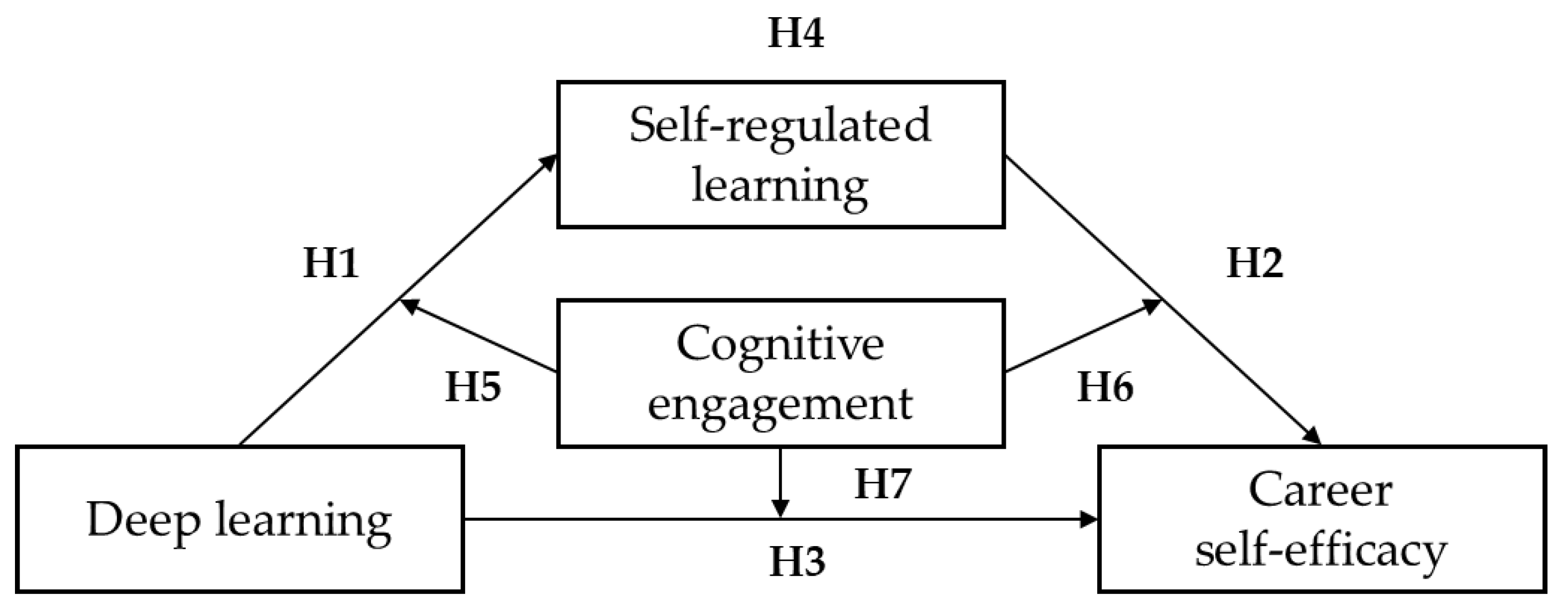
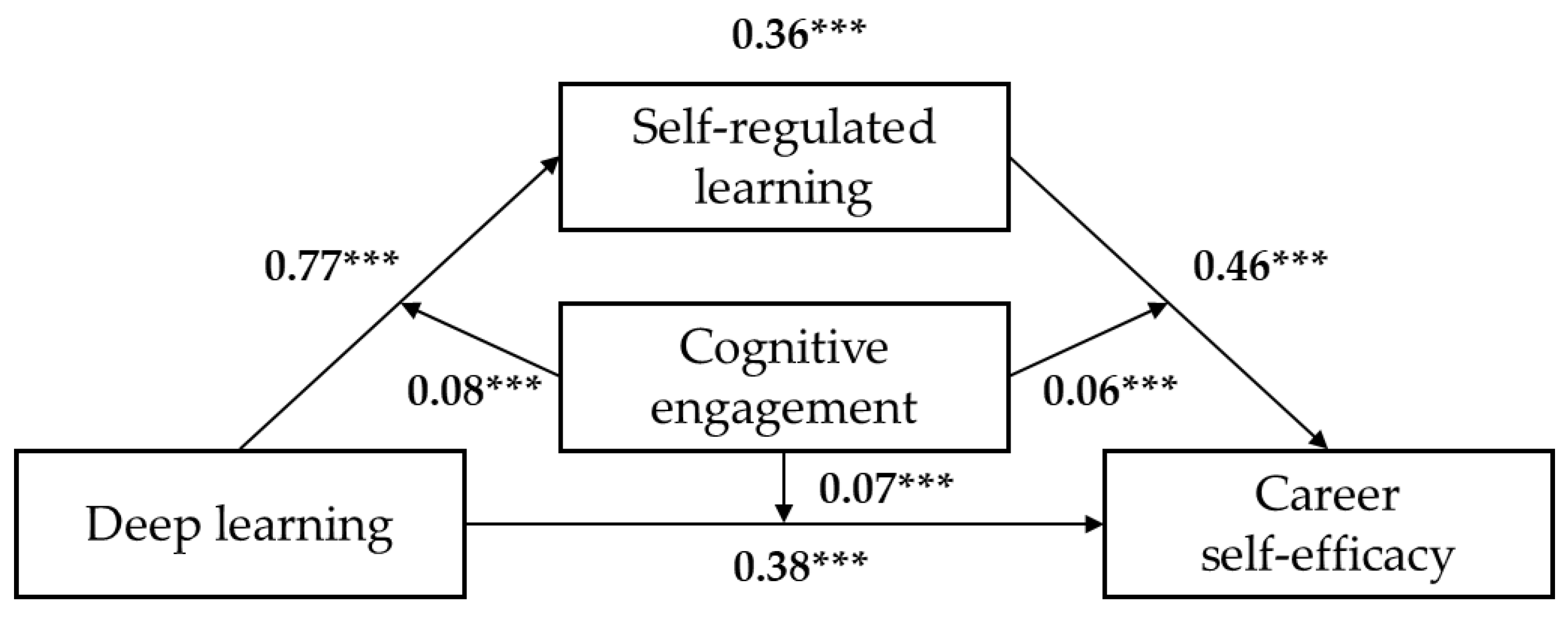
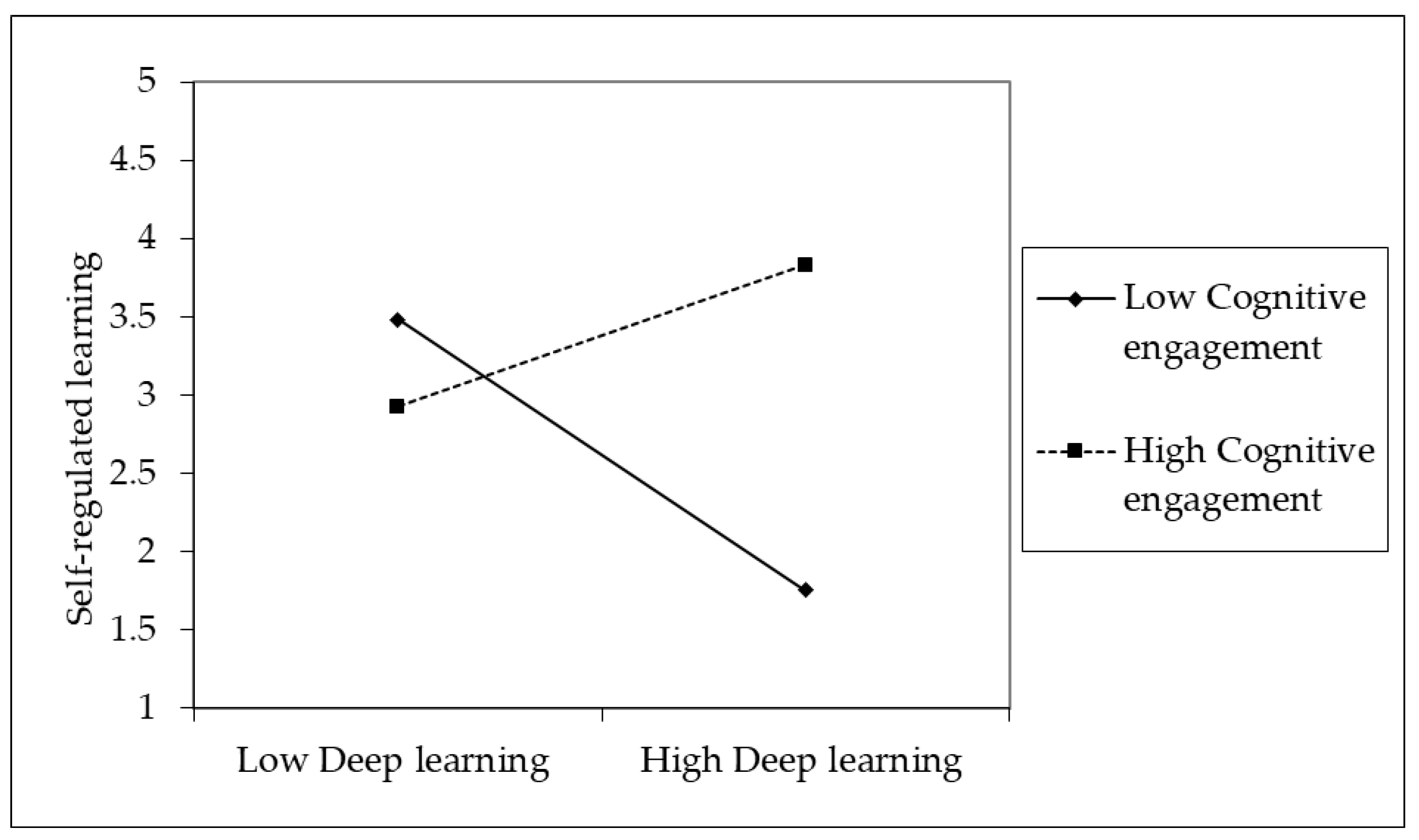
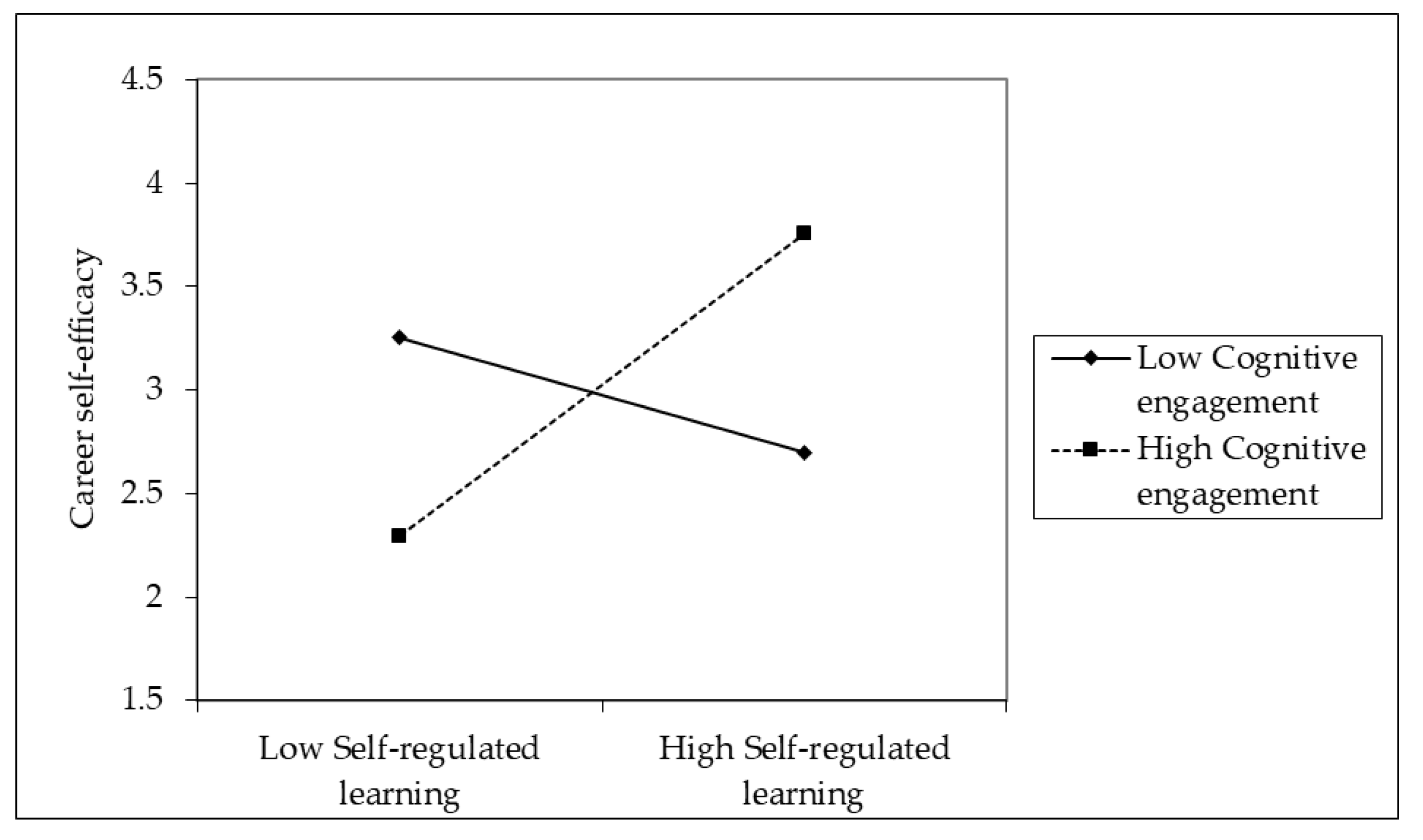
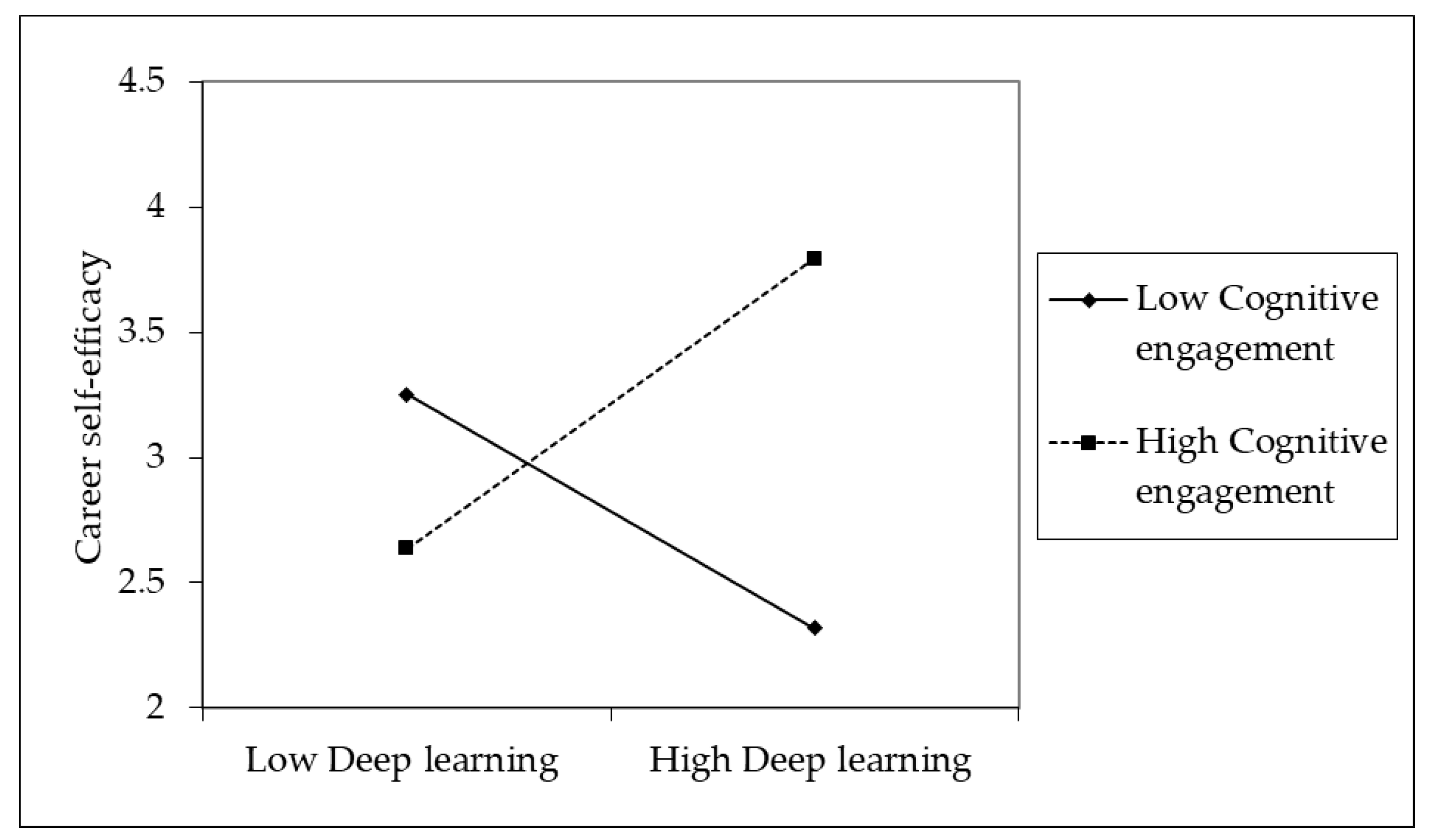
| Characteristics (n = 481) | Frequency (s) | Percentage (%) |
|---|---|---|
| Gender | ||
| Female | 309 | 64.2 |
| Male | 172 | 35.7 |
| Age | ||
| 20 years or below | 0 | 0 |
| 21–30 years | 460 | 95.6 |
| 31–40 years | 14 | 2.9 |
| 41–50 years | 7 | 1.5 |
| 51–60 years | 0 | 0 |
| 61 years or above | 0 | 0 |
| Education level | ||
| Lower secondary | 0 | 0 |
| Upper secondary | 4 | .8 |
| Tertiary | 462 | 96 |
| Master’s degree or higher | 15 | 3.1 |
| Internship unit | ||
| Hotel | 256 | 53.2 |
| Restaurant | 190 | 39.5 |
| Others | 35 | 7.2 |
| Internship location | ||
| Northern Taiwan | 209 | 43.4 |
| Eastern Taiwan | 99 | 20.6 |
| Western Taiwan | 109 | 22.7 |
| Southern Taiwan | 53 | 11 |
| Construct | χ2 | χ2/df | GFI | AGFI | SRMR | CFI | NNFI | RMSEA |
|---|---|---|---|---|---|---|---|---|
| Deep learning approach | 2.83 | 1.41 | 0.99 | 0.99 | 0.01 | 0.99 | 0.99 | 0.03 |
| Self-regulated learning | 22.58 | 2.51 | 0.98 | 0.96 | 0.02 | 0.99 | 0.98 | 0.06 |
| Career self-efficacy | 18 | 3.9 | 0.95 | 0.91 | 0.03 | 0.97 | 0.96 | 0.08 |
| Overall model | 550.68 | 3.7 | 0.89 | 0.85 | 0.06 | 0.93 | 0.92 | 0.08 |
| 1 | 2 | |
|---|---|---|
| Deep learning approach | ||
| Self-regulated learning | 293.71 | |
| Career self-efficacy | 382.04 | 464.54 |
| Constructs | CR | AVE |
|---|---|---|
| Deep learning approach | 0.85 | 0.59 |
| Self-regulated learning | 0.89 | 0.57 |
| Career self-efficacy | 0.92 | 0.57 |
| Mean | S.D. | 1 | 2 | 3 | |
|---|---|---|---|---|---|
| Deep learning approach | 5.29 | 0.85 | (0.74) | ||
| Self-regulated learning | 5.49 | 0.77 | 0.68 ** | (0.74) | |
| Career self-efficacy | 5.03 | 0.91 | 0.71 ** | 0.72 ** | (0.75) |
| Hypothesis | Path | Estimate | p-Value | Percentile 95% CI [Lower, Upper] | Result |
|---|---|---|---|---|---|
| H1 | DLA→SR | 0.77 | p < 0.001 | [0.53, 0.81] | Supported |
| H2 | SR→CE | 0.46 | p < 0.001 | [0.33, 0.69] | Supported |
| H3 | DLA→CE | 0.38 | p < 0.001 | [0.20, 0.52] | Supported |
| H4 | DLA→SR→CE | 0.36 | p < 0.001 | [0.24, 0.50] | Supported |
| H5 | DLA × CG→SR | 0.08 | p < 0.001 | [0.06, 0.09] | Supported |
| H6 | SR × CG→CE | 0.06 | p < 0.001 | [0.04, 0.09] | Supported |
| H7 | DLA × CG→CE | 0.07 | p < 0.001 | [0.09, 0.06] | Supported |
Publisher’s Note: MDPI stays neutral with regard to jurisdictional claims in published maps and institutional affiliations. |
© 2022 by the authors. Licensee MDPI, Basel, Switzerland. This article is an open access article distributed under the terms and conditions of the Creative Commons Attribution (CC BY) license (https://creativecommons.org/licenses/by/4.0/).
Share and Cite
Wang, C.-J.; Hsieh, H.-Y. Effect of Deep Learning Approach on Career Self-Efficacy: Using Off-Campus Internships of Hospitality College Students as an Example. Sustainability 2022, 14, 7594. https://doi.org/10.3390/su14137594
Wang C-J, Hsieh H-Y. Effect of Deep Learning Approach on Career Self-Efficacy: Using Off-Campus Internships of Hospitality College Students as an Example. Sustainability. 2022; 14(13):7594. https://doi.org/10.3390/su14137594
Chicago/Turabian StyleWang, Chung-Jen, and Hsin-Yun Hsieh. 2022. "Effect of Deep Learning Approach on Career Self-Efficacy: Using Off-Campus Internships of Hospitality College Students as an Example" Sustainability 14, no. 13: 7594. https://doi.org/10.3390/su14137594
APA StyleWang, C.-J., & Hsieh, H.-Y. (2022). Effect of Deep Learning Approach on Career Self-Efficacy: Using Off-Campus Internships of Hospitality College Students as an Example. Sustainability, 14(13), 7594. https://doi.org/10.3390/su14137594







